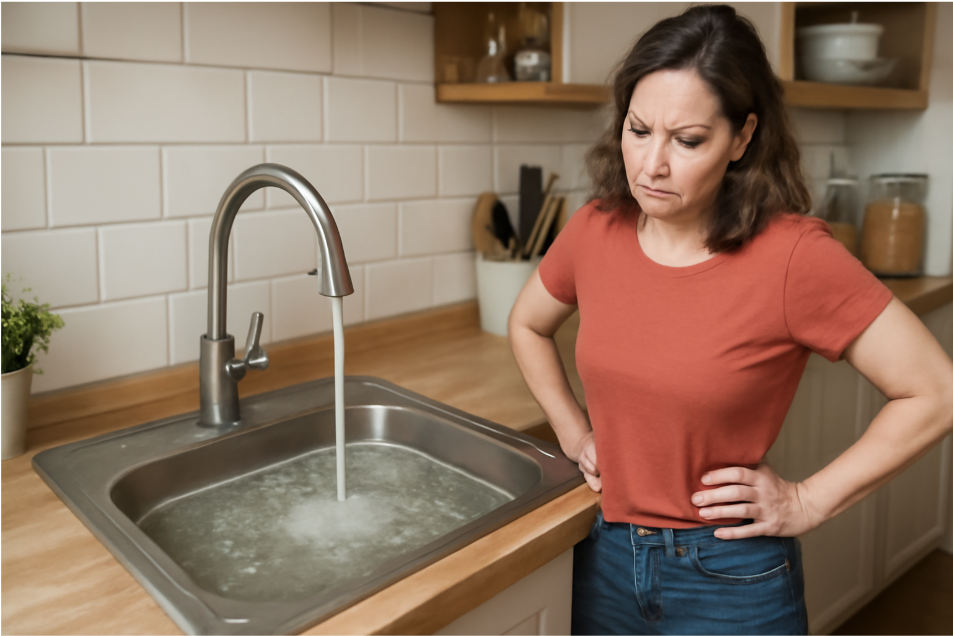
Effective Tips for Fixing a Clogged Garbage Disposal: Quick Solutions You Can Do Yourself
Is your garbage disposal clogged, making strange noises or refusing to drain properly? 
In this guide, we’ll walk you through quick and simple solutions that anyone, regardless of experience, can follow to clear a blockage and get your disposal running smoothly again. Whether it’s food waste buildup, a stuck blade, or grease causing a mess, we’ve got the steps you need to fix it in no time. Keep reading to learn how to resolve this issue with confidence and restore your kitchen to full functionality!
Table of Contents
ToggleCommon Causes of a Clogged Garbage Disposal
A clogged garbage disposal can happen for several reasons, many of which are easily avoidable. Understanding the causes can help you prevent future issues and keep your disposal running smoothly. Here are the most common culprits:
- Food Waste Buildup
: Overloading your disposal with large food scraps or fibrous items like potato peels and corn husks can create blockages. Always cut up large pieces and feed them gradually into the disposal.
- Hard Objects
: Accidentally dropping silverware, bones, or other non-food items down the drain can jam the blades. Be mindful of what goes in—only soft food scraps should be disposed of.
- Grease and Oil
: Pouring grease or oil down the disposal is a major no-no. When they cool, they solidify and cause serious clogs. Always dispose of fats and oils in the trash, not the sink.
- Improper Use
: Running the disposal without enough water or using it too aggressively can cause jams. Always run cold water while the disposal is on to help food particles move down the drain.
- Long-Term Lack of Maintenance
: Without regular cleaning, food particles can build up over time, leading to slower drainage or a full clog. Keeping your disposal clean is essential to prevent these issues.
By understanding these common causes, you’ll be better equipped to avoid and address any clogs that pop up!
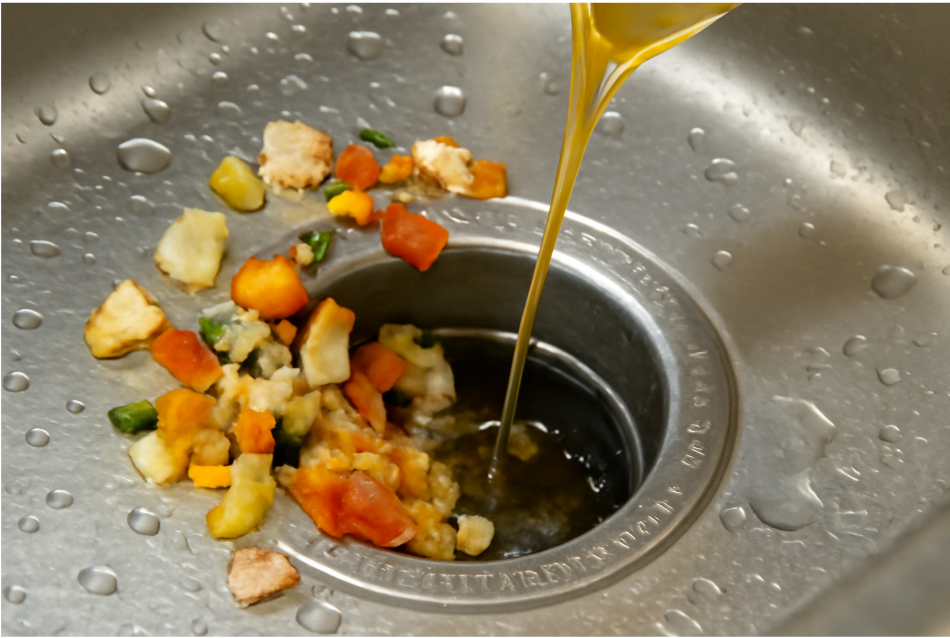
Step-by-Step Guide to Fixing a Clogged Garbage Disposal
When your garbage disposal gets clogged, don’t stress! Most blockages are easy to fix with a few simple steps. Here’s a clear, step-by-step guide that anyone can follow to clear a clogged disposal and get it back in working order.
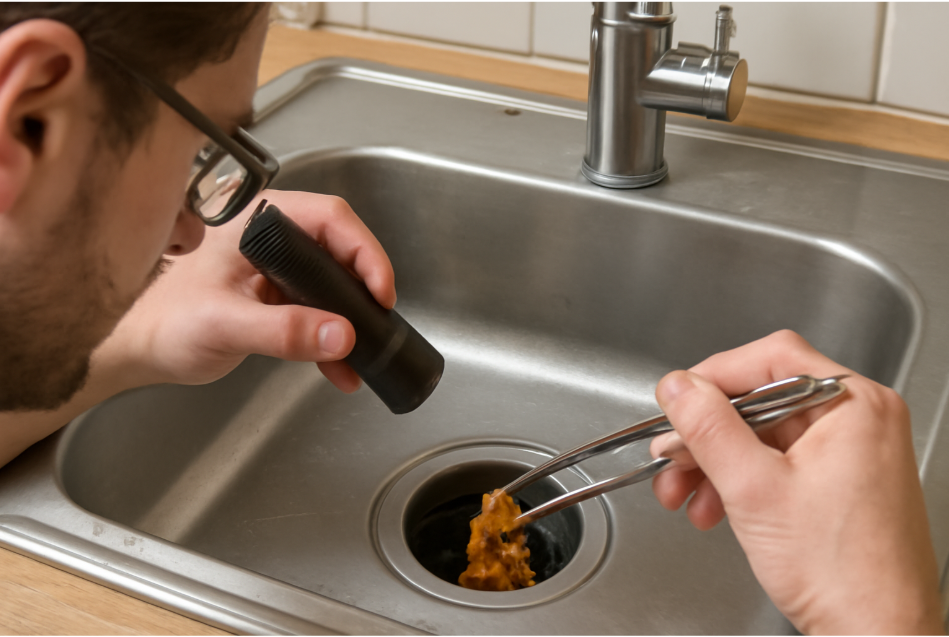
Step 1: Turn Off the Power 
Before doing anything, make sure the power is off! Safety first! You can either unplug the garbage disposal from under the sink or turn off the circuit breaker. This prevents any accidents while you’re working.
Step 2: Check for Visible Blockages 
Take a look inside the disposal using a flashlight. If you spot any large chunks of food, silverware, or debris, carefully remove them using tongs or pliers. Never use your hands to remove items, as there might still be sharp edges or hidden parts that could hurt you.
Step 3: Use the Reset Button 
Many garbage disposals have a reset button located on the bottom of the unit (near the motor). If your disposal has stopped working altogether, press this button to restart it. Wait a few minutes, then test it again to see if it’s functioning. This simplefix can sometimes clear minor issues!
Step 4: Free the Blades with a Wooden Spoon 
If the blades seem jammed or stuck, use a wooden spoon handle to gently rotate the blades inside the disposal. Never use metal tools or your fingers, as they could damage the unit. By turning the blades manually, you can often dislodge any debris that’s causing the blockage.
Step 5: Try the Baking Soda and Vinegar Method 

If the disposal still isn’t draining, try the baking soda and vinegar trick! Pour about one cup of baking soda into the disposal, followed by one cup of vinegar. Let the mixture sit for 10-15 minutes, as the fizzing reaction helps break down grease and food particles. Afterward, run hot water to flush out any remaining gunk.
Step 6: Use an Allen Wrench to Manually Rotate the Blades 
If your disposal has a hex-shaped hole on the bottom (usually near the motor), insert an Allen wrench into it. Turn the wrench back and forth to loosen any stuck debris or food particles. This will manually move the blades, helping to free the blockage.
Step 7: Check the Drain Line for Blockages 
If your garbage disposal is still clogged after trying these steps, the issue might lie in the drain line. Inspect the drain pipe that connects the disposal to the sink drain. If there’s a visible clog, carefully remove it. Sometimes, a plunger can help dislodge any remaining debris in the drain.
Step 8: Turn Everything Back On 
Once you’ve cleared the blockage, it’s time to test the disposal. Plug it back in (or flip the breaker switch) and run cold water through it while switching the disposal back on. Check if it’s draining properly and making its usual sounds.
Tips for Maintaining Your Garbage Disposal to Prevent Future Clogs
Now that you’ve fixed your clogged garbage disposal, it’s time to keep it running smoothly! Regular maintenance is key to preventing future clogs and ensuring your disposal lasts longer. Here are some simple, actionable tips to maintain your garbage disposal and keep it in top condition.
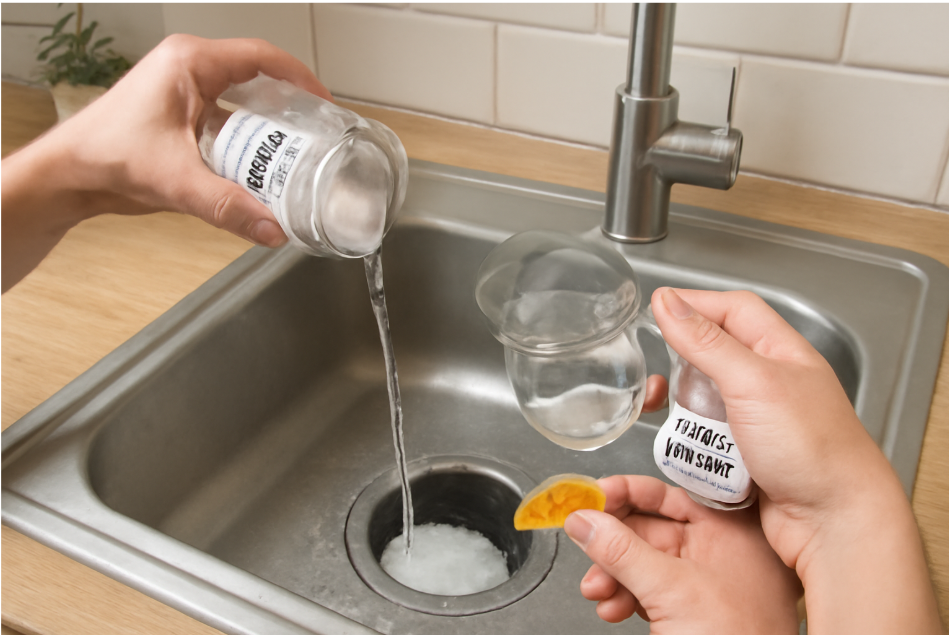
1. Clean Regularly 
Regular cleaning is one of the best ways to prevent clogs. Once a week, run a handful of ice cubes through the disposal to help clean the blades and scrape away any buildup. You can also add a cup of baking soda and follow it with a cup of vinegar for a natural, fresh clean. Let it sit for a few minutes, then flush with hot water. This helps eliminate odors and keeps food particles from accumulating.
2. Avoid Hard or Fibrous Foods 
Certain foods can wreak havoc on your garbage disposal. Avoid putting items like bones, corn husks, potato peels, and egg shells down the drain. These foods are either too hard or too fibrous and can cause serious blockages. Instead, dispose of them in the trash.
3. Use Cold Water 
Always run cold water while the disposal is on. Cold water helps solidify any grease or oils that may be in the disposal, making it easier for the blades to chop them up and flush them through the pipes. Hot water, on the other hand, can liquefy grease, causing it to stick to the inside of the pipes.
4. Freshen It Up with Citrus Peels 
To keep your disposal smelling fresh, toss a few lemon or orange peels into the drain. These not only help freshen up the scent but also act as a mild abrasive to scrub the inside of the disposal. This is a great natural cleaner that keeps your disposal smelling great!
5. Perform Monthly Maintenance 
Once a month, run a baking soda and vinegar treatment through your disposal, followed by hot water. This helps break down any remaining food particles and prevents grease buildup. This simple routine can extend the life of your disposal and keep it running efficiently.
When to Call a Professional
While many garbage disposal issues can be easily fixed with a few DIY steps, there are times when it’s best to call in a professional. Knowing when to seek expert help can save you time, effort, and potentially costly repairs.
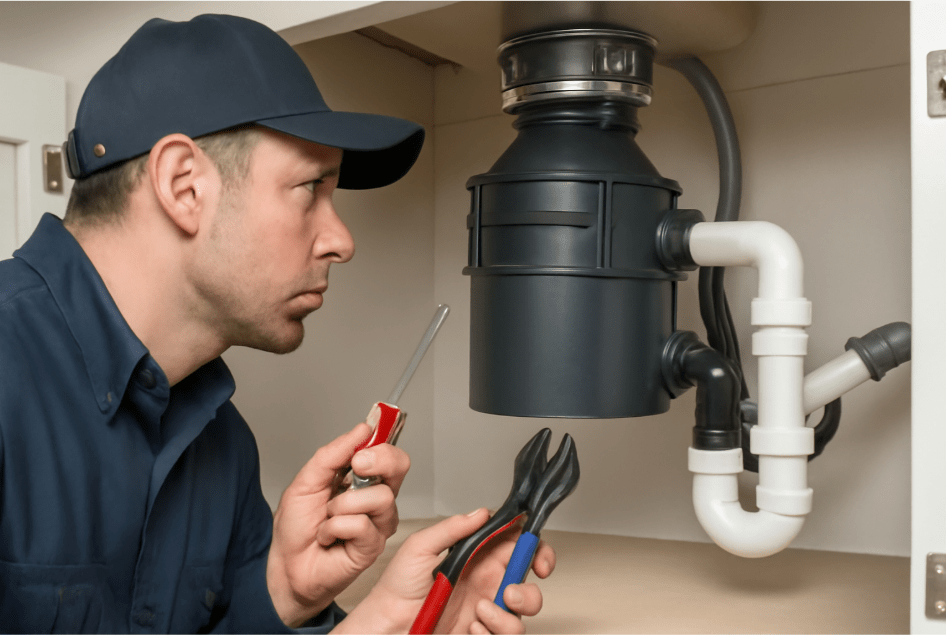
1. If the Reset Button Doesn’t Work 
If your garbage disposal stops working and pressing the reset button doesn’t solve the problem, there might be a deeper electrical issue. A professional can diagnose and repair electrical components safely.
2. Persistent Clogs 
If you’ve tried multiple DIY fixes but the clogs keep coming back, it could be a sign of a bigger problem—like a blockage in the drain pipes or a malfunctioning motor. A plumber will have the tools to clear more serious blockages and check the system for damage.
3. Unusual Noises or Smells 
If your garbage disposal is making strange noises like grinding or humming, or emitting a burning smell, it’s time to call a professional. These are often signs of a malfunctioning motor, jammed blades, or overheating.
4. Leaking Disposal 
If your disposal is leaking water, it’s important to call a professional right away. Leaks could indicate a cracked unit or improper installation, which requires expert repair.

A clogged garbage disposal can be a frustrating problem, but with the right knowledge and tools, you can fix most issues on your own! By following the [tips for fixing a clogged garbage disposal] shared in this guide, you’ll be able to tackle common blockages with confidence. Whether it’s clearing debris, using the reset button, or performing regular maintenance, these simple steps can keep your disposal in top shape and prevent future problems.
Remember, prevention is key—with a little regular care, like cleaning and avoiding certain foods, your garbage disposal will serve you well for years to come. If you ever run into a problem that’s beyond your DIY skills, don’t hesitate to reach out to a professional to handle the job safely and effectively.
Now that you know how to keep your disposal in great working condition, go ahead and give it the care it deserves. Happy fixing!
Frequently Asked Questions (FAQs)
1. How do I fix a clogged garbage disposal?
To fix a clogged garbage disposal, start by turning off the power. Then, check for visible blockages using tongs or pliers. Press the reset button, and if the blades are jammed, gently turn them with a wooden spoon handle or an Allen wrench. Lastly, use baking soda and vinegar to clear out any remaining debris.
2. What can I put down my garbage disposal to avoid clogs?
To prevent clogs, only dispose of soft, biodegradable food waste like fruit scraps, small vegetable pieces, and ice cubes. Avoid fibrous foods like corn husks, potato peels, and bones, as well as grease or oil, which can cause blockages.
3. Why is my garbage disposal humming but not working?
A humming garbage disposal usually means the motor is running but the blades are jammed. Try using an Allen wrench to manually turn the blades and free any debris. If that doesn’t work, the problem may be electrical or mechanical, and it’s time to call a professional.
4. How often should I clean my garbage disposal?
It’s best to clean your garbage disposal once a week. Regularly running ice cubes, baking soda, and vinegar through it will help eliminate odors, prevent buildup, and keep the blades sharp.
5. Can I use hot water to clean my garbage disposal?
While hot water is great for flushing debris, always run cold water while the disposal is running. Cold water helps solidify grease and oil, allowing the blades to chop them up before they can cause clogs in the pipes.
6. What should I do if my garbage disposal is leaking?
If your garbage disposal is leaking, it may be due to a cracked unit, loose connections, or improper installation. Turn off the power, inspect the unit, and check the connections. If the leak persists, it’s best to call a professional to fix the issue.
7. How do I stop my garbage disposal from smelling?
To stop bad smells, grind up lemon or orange peels in your garbage disposal. You can also use a mixture of baking soda and vinegar to clean it regularly. This helps freshen it up while removing trapped food particles that cause odors.
8. When should I call a plumber for my garbage disposal?
If your disposal continues to clog despite your efforts, or if you hear unusual noises, smell burning, or notice water leaking, it’s time to call a plumber. These could be signs of a more serious issue that requires professional attention.



